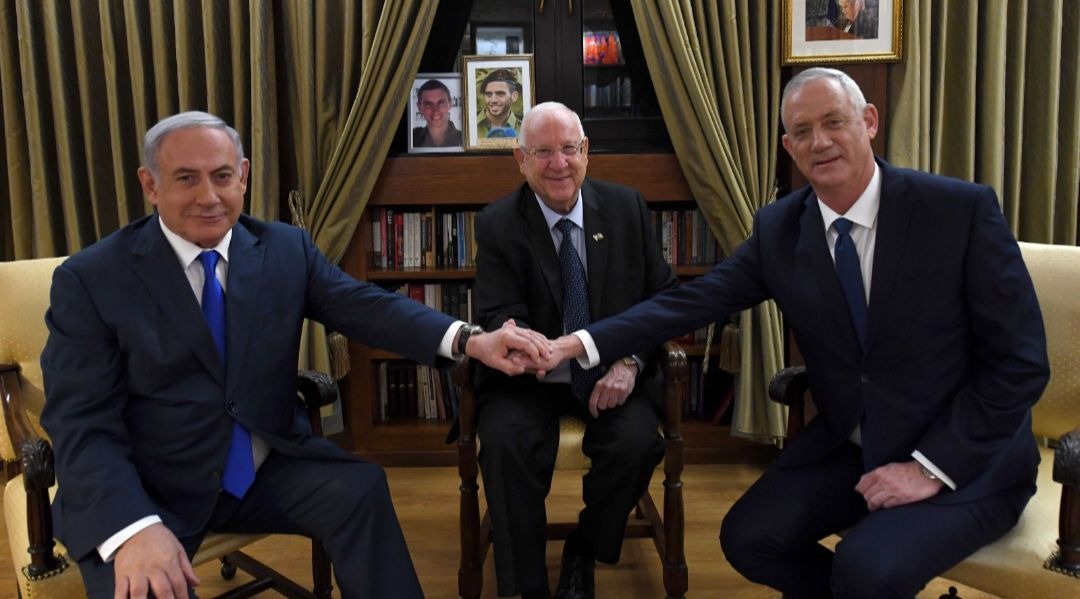 Prime Minister Benjamin Netanyahu, left, and Benny Gantz flank Israeli President Reuven Rivlin at the president’s residence in Jerusalem, Sept. 23, 2019, When leaders were still shaking hands (Haim Zach/Israeli Government Press Office)
Prime Minister Benjamin Netanyahu, left, and Benny Gantz flank Israeli President Reuven Rivlin at the president’s residence in Jerusalem, Sept. 23, 2019, When leaders were still shaking hands (Haim Zach/Israeli Government Press Office) We call this format a Timesaver Guide to Israel’s Coming Elections. This will be a usual feature on Rosner’s Domain until next Election Day, March 2, 2020. We hope to make it short, factual, devoid of election hype.
Bottom Line
Less than a month, and no change.
Main News
The polls refuse to show signs of change.
The Trump Plan did not change political minds and hearts. In fact, it somewhat complicated Netanyahu’s stance, as he promised a lot (annexation) and delivered a little (statements, words, intentions).
Security concerns, as more rockets and balloons fly from Gaza, and a few attacks on soldiers and civilians shook the country on Thursday can still have impact on voters but are not yet registered in the polls.
Lieberman refuses to say that he will not sit in the same coalition with Meretz (as he announced in the previous rounds). This opened the door to speculation that a center-left minority coalition supported from the outside by the United Arab Party is becoming a possibility.
The vibe – well, there is no vibe. This is one of the most tired election cycles ever.
The Blocs and Their Meaning
The basic construct of the Israeli electorate remains basically unchanged. Following the release of the Trump plan, there were small gains for the right. Not enough to form a coalition.

Trends to Watch
Polls conducted by pollster Menachem Lazar for Maariv (listen to Lazar discussing his polls on Rosner’s Podcast) reveal something about the preferences of Israelis in case the electoral situation does not change. What coalition would the voters prefer to see when the dust is settled down? Here are the options presented to voters, and the percentage allocated for each.

And here is a clearer way to look at these numbers, as they basically contain to types of coalitions, unity (with or without Israel Beiteinu) and narrow coalitions. Note that a unity coalition is a possibility according to the polls, that a narrow right-religious coalition is impossible according to all polls, and that a narrow center-left coalition supported by the Arab Party is possible – but also the least desired option.

The following table shows that the voters of the main two parties want unity, while the voters of smaller and more radical parties want their party to be a member of a narrow coalition. That’s only natural, as these parties aren’t necessary in a unity coalition.

One important last thing: these options were presented without specifying if Netanyahu will be the Prime Minister in a unity government. So, it is possible that when a B&W voter says “unity” he or she only mean it in a case Netanyahu is out of the picture. In fact, when IDI pollsters asked Israeli to identify the topic that will determine the fate of the election, many of them said that the Netanyahu investigation is the most important issue on the agenda. As for the question how such issue goes hand in hand with a unity government, your answer is as good as mine.























 More news and opinions than at a Shabbat dinner, right in your inbox.
More news and opinions than at a Shabbat dinner, right in your inbox.